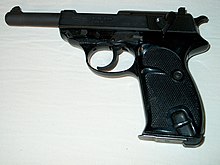Walther P38: Difference between revisions
No edit summary |
m Reverted edits by 76.184.84.73 (talk) to last version by Sus scrofa |
||
| Line 6: | Line 6: | ||
|type=[[Semi-automatic pistol]] |
|type=[[Semi-automatic pistol]] |
||
|is_ranged=yes |
|is_ranged=yes |
||
|service=1938- |
|service=1938-1945 |
||
|used_by=See Users |
|used_by=See Users |
||
|wars=[[World War II]] |
|wars=[[World War II]] |
||
Revision as of 01:49, 26 March 2010
| P38 | |
|---|---|
| File:Walter HP Speerwerke 1428.jpg P38 | |
| Type | Semi-automatic pistol |
| Place of origin | |
| Service history | |
| In service | 1938-1945 |
| Used by | See Users |
| Wars | World War II |
| Production history | |
| Designed | 1938 |
| Manufacturer | Carl Walther Waffenfabrik, Mauser Werke, Spreewerke |
| Produced | Walther P38 1939-1945 Pistole P1 1957-2000 |
| Variants | P1, P38K, P38 SD, P4 |
| Specifications | |
| Mass | 800 g (1 lb 12 oz) |
| Length | 216 mm (8.5 in) |
| Barrel length | 125 mm (4.9 in) |
| Cartridge | 9x19mm Parabellum |
| Action | Short recoil, locked breech |
| Muzzle velocity | 365 m/s (1,200 ft/s) |
| Effective firing range | Sights set for 25 m (82 ft) |
| Maximum firing range | 50 m (164 ft) effective range |
| Feed system | 8-round detachable single-stack magazine |
| Sights | Rear notch and front blade post |
The Walther P38 is a 9 mm pistol that was developed by Walther as the service pistol of the Wehrmacht at the beginning of World War II. It was intended to replace the costly Luger P08, the production of which was scheduled to end in 1942.
Development
The P38 concept was accepted by the German military in 1938 but production of actual prototype ("Test") pistols did not begin until late 1939. Walther began manufacture at their plant in Zella-Mehlis and produced three series of "Test" pistols, designated by a "0" prefix to the serial number. The third series satisfied the previous problems and production for the Heer (German Army) began in mid-1940, using Walther's military production identification code "480". After a few thousand pistols the Heer changed all codes from numbers to letters and Walther was given the "ac" code.[citation needed]

Three firms made components for P38 production:[citation needed]
- Fabrique Nationale—slides, frames and locking blocks (M or M1)
- Ceska Zbrojovka, CZ (Böhmische Waffenfabrik)-- barrels (fnh)
- Erste Nordböhmische Metallwarenfabrik—magazines (jvd)
Design details
The P38 uses a double action trigger design similar to that of the earlier Walther PPKs, and a loaded chamber indicator is also incorporated.[1] The P38 was the first locked-breech pistol to use a double-action trigger (the earlier double-action PPK was an unlocked blowback design, but the more powerful 9x19mm Parabellum round used in the P38 mandated a locked breech design). The shooter could load a round into the chamber, use the de-cocking lever to safely lower the hammer without firing the round, and carry the weapon loaded with the hammer down. A pull of the trigger, with the hammer down, fired the first shot and the operation of the pistol ejected the fired round and reloaded a fresh round into the chamber, all features found in many modern day handguns.
The first designs submitted to the German Army featured a locked breech and a hidden hammer, but the German Army requested that it be redesigned with an external hammer. This led to the subsequent adoption of the P38 in 1940. Several experimental versions were later created in .45 ACP, and .38 Super, but these were never mass-produced. In addition to the 9 mm Parabellum version, some 7.65x22mm Parabellum and some .22 Long Rifle versions were also manufactured and sold.
The fixed - barrel design mechanism operates by use of a wedge-shaped locking block underneath the breech. When the pistol is fired both the barrel and slide recoil for a short distance together, where the locking block drives down, disengaging the slide and arresting further rearward movement of the barrel. The slide however continues its rearward movement on the frame, ejecting the spent case and cocking the hammer before reaching the end of travel. Two return springs located on either side of the frame and below the slide, having been compressed by the slide's rearward movement, drive the slide forward, stripping a new round from the magazine, driving it into the breech and, in the process, re-engages the barrel; ending its return travel with a fresh round chambered, hammer cocked and ready to repeat the process.
Initial production P38 pistols were fitted with walnut grips, but these were later succeeded by Bakelite grips.[2]
Variants

A slightly modified version of the P38 called the P1 was adopted by the Bundeswehr in 1957 and remained in service until the early 1990s. The P1 had a receiver made of aluminum alloy, instead of steel to reduce weight. There was also a short-barreled version of the P1 called the P4.
An improved version of the P38, the Walther P5, was developed in the late 1970s and was adopted by the police forces of Rhineland-Palatinate and Baden-Württemberg.
Users
 Chile: Chilean Army.[3]
Chile: Chilean Army.[3] Macedonia[4]
Macedonia[4] Nazi Germany[3]
Nazi Germany[3] Norway: Norwegian Armed Forces.[5]
Norway: Norwegian Armed Forces.[5] Portugal: Portuguese Army.[3]
Portugal: Portuguese Army.[3] West Germany[3]
West Germany[3]
References
- ^ Military Small Arms of the 20th Century, Ian Hogg, John Weeks
- ^ "P38 - 9mm semi-automatic pistol - history & development of the weapon". Hellcat Patriots' Rifle Club. Retrieved 2009-04-16.
- ^ a b c d Diez, Octavio (2000). Armament and Technology. Lema Publications, S.L. ISBN 84-8463-013-7.
- ^ Jones, Richard (2009). Jane's Infantry Weapons 2009-2010. Jane's Information Group. p. 899. ISBN 0710628692.
- ^ Marchington, James (2004). The Encyclopedia of Handheld Weapons. Lewis International, Inc. ISBN 1-930983-14-X.
